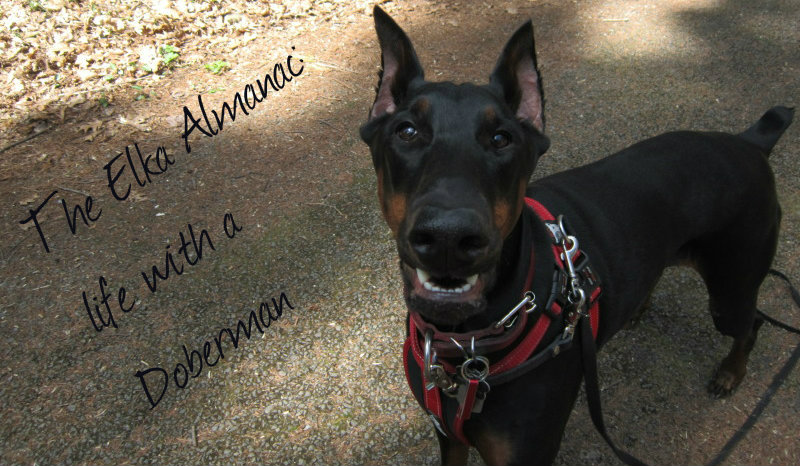Though I was excited I cannot, however, claim that Elka wanted to be read to!
How to Talk to Your Dog is written by Jean Craighead George and illustrated by Sue Truesdell. I was at first delighted by the slightly cartoony art style of the dog, and the inclusion of actual photographs of the author, and the two interacting with one another to go along with the text. However, the text tells you to do things like "sniff towards your dog's nose" to say hello. That's right, it tells kids to get in dog's faces, which is all well and good if it's say, Elka. I can put my face in hers (and she puts her face in mine) and I don't have any concern about it. Is that true of all dogs? No, and I wouldn't want a kid to think that it was. This book also tells you that a dog sniffing people crotches is "pulling rank", i.e. showing she is superior in the "pack" to the person, and thaty ou should use "threat talk" to correct it by holding something over your dog's head, like a piece of folded newspaper or a glove, because it is "disconcerting. Enemies like eagles come from above." Granted, most people don't like to be crotch-sniffed by a dog, but I'm not sure rank has anything to do with it. I'm not a scientist, but my impression is crotch, armpits, and feet are where people are the most smelly, and a dog's sense of smell is the strongest sense. So, why not utilize a smelly area and a best sense in order to get to know somebody? I could be wrong, I don't know. I'm not the one with the picture book published. So, How to Talk to Your Dog is cute, but may or may not contain a lot of bad (perhaps even dangerous) advice, and a lot of outdated advice as pertains to our domestic dogs.
In direct counterpoint, May I Pet Your Dog? is a clear and concise book about meeting dogs. The little boy who is the main character is instructed to always ask the owner before petting a dog. He's coached to hold out his hand, "fingers down", so that the dog can sniff, before petting. The book also mentions that you should never reach over a stranger dog's head, because it might scare him, and that if a dog growls at you, to look away and stand very still until he or she is gone. At the end of the story, there is a section that reviews things: never approach a dog without an owner, don't interrupt a working service dog, "don't run or shout around dogs", never put your face close to any dog's face. May I Pet Your Dog? is a book I would recommend be read to every child; even if you don't have your own dog, and have no intention of getting one, it's good groundwork for how to behave around strange dogs.
Last is Doggy Whys? by Lila Prap. This book contains a lot of questions about dogs, such as "Why are there so many kinds of dogs?" and "Why are some dogs more obedient than others?" Each question is a two page spread, and there are "silly" answers down the left hand side, and the "proper" answer on the right, and then a specific breed is pictured in the middle and has a little blurb about it. For example, a silly answer for "Why are there so many kinds of dogs" is "because they all forgot that they are supposed to look like wolves." A "silly" answer for "Why are some dogs more obedient than others" are "because they are beaten" or "because they are stupid". Hmm. The "real" obedient answer starts out "How obedient a dog is depends on its owner, especially on how much attention and teaching the owner gives the dog." So that's all right, but those silly answers are less than funny, and are really kind of sad. Overall, the proper answers seem to be good ones, and the breed information is all right. Evidently, "Bull terriers were bred for dog fights, and their bite is among the worst dog bites of all", something that I've never heard, but then, I haven't read all that many scientific studies comparing dog bites. If there are any. So I'm a little skeptical of that being presented to children as fact, though saying a Dalmatian is "very energetic and needs lots of exercise" is spot on from what I know.
I guess my overall point is to be careful about what information you give your kids about dogs. Some things may be cute, but not practical, and some things may or may not be entirely wrong. Definitely educate your kid about not running and screaming around a dog, about not grabbing at or chasing a dog, not riding your bike at a dog (this one's my favorite), that kind of thing. Dogs are not robots, nor are they stuffed animals; they have reactions we may not anticipate, and they may have strong feelings about what's going on around them. So, be educated, and be safe.





No comments:
Post a Comment